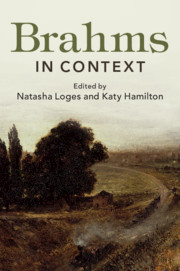Book contents
- Brahms in Context
- Brahms in Context
- Copyright page
- Dedication
- Contents
- Illustrations
- Music Examples
- Notes on Contributors
- Preface
- Abbreviations
- Part I Personality, People and Places
- Part II Identities, Environments and Influences
- Part III Performance and Publishing
- Chapter 19 Singers
- Chapter 20 Conductors
- Chapter 21 Pianists
- Chapter 22 Other Instrumentalists
- Chapter 23 Instruments
- Chapter 24 Publishers
- Chapter 25 Copyright
- Part IV Society and Culture
- Part V Reception and Legacy
- Further Reading
- Index
- References
Chapter 23 - Instruments
from Part III - Performance and Publishing
Published online by Cambridge University Press: 15 May 2019
- Brahms in Context
- Brahms in Context
- Copyright page
- Dedication
- Contents
- Illustrations
- Music Examples
- Notes on Contributors
- Preface
- Abbreviations
- Part I Personality, People and Places
- Part II Identities, Environments and Influences
- Part III Performance and Publishing
- Chapter 19 Singers
- Chapter 20 Conductors
- Chapter 21 Pianists
- Chapter 22 Other Instrumentalists
- Chapter 23 Instruments
- Chapter 24 Publishers
- Chapter 25 Copyright
- Part IV Society and Culture
- Part V Reception and Legacy
- Further Reading
- Index
- References
Summary
During the long nineteenth century, the design of most musical instruments changed considerably. While the late nineteenth-century orchestra may be familiar in terms of size, configuration and instrumental design, musicians of Mozart and Haydn’s era would be forgiven for not immediately recognising the descendants of the instruments that they themselves played. The industrial revolution generated new technologies and ways of manufacturing which impacted upon the musical world. Woodwind instruments gained more keys, brass instruments acquired new valve technology, strings would eventually transition from gut to metal strings, and metal-framed pianos allowed for more stable instruments with a larger pitch and dynamic range. Within individual histories of these instruments, it is difficult to pinpoint when changes were accepted and adopted. Communities (e.g. soloists, orchestral musicians, amateurs) and countries varied enormously.
- Type
- Chapter
- Information
- Brahms in Context , pp. 227 - 235Publisher: Cambridge University PressPrint publication year: 2019

